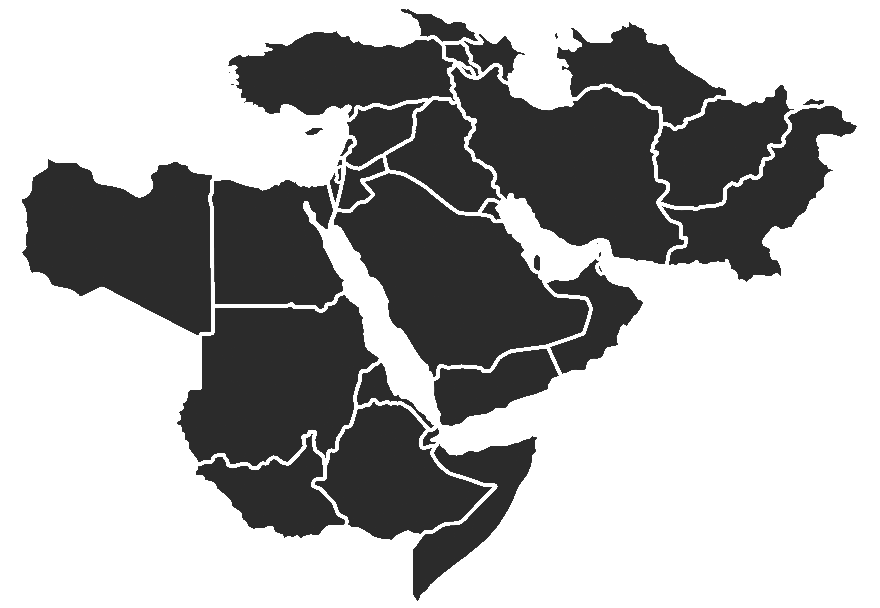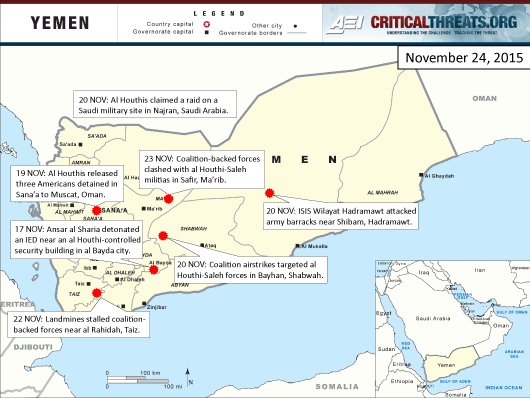Both al Qaeda in the Arabian Peninsula (AQAP) and the Islamic State of Iraq and al Sham (ISIS) are exploiting Yemen’s ongoing security vacuum to expand throughout the country. ISIS’s strength is growing in parts of eastern Hadramawt governorate and AQAP continues to strengthen relations alongside tribal militias in al Bayda and Taiz.
ISIS-linked groups in Yemen are increasing their operational capabilities and attempting to drive recruitment away from AQAP, which remains the dominant jihadist organization in Yemen. ISIS Wilayat Hadramawt detonated an improvised explosive device (IED) and a suicide vehicle-borne improvised explosive device (SVBIED) at a Yemeni military checkpoint and captured three Yemeni military barracks in Shibam, Hadramawt governorate in eastern Yemen on November 20. The attacks killed at least 19 soldiers and incurred at least 35 casualties, according to a Yemeni security source. The raids’ location along the Sayun-al Qatan path in central Hadramawt may signal an attempt to take control of east-west smuggling routes running through Yemen’s Empty Quarter. ISIS also launched a media blitz discrediting AQAP, including the release of multiple anti-AQAP videos by ISIS Wilayat Ninawa and ISIS Wilayat al Khayr on November 16 and a criticism of AQAP’s alleged partnerships with Yemeni officials in ISIS’s English-language magazine, Dabiq. (Sources available upon request)
AQAP militants are fighting alongside anti-al Houthi popular resistance forces in central Yemen. AQAP’s insurgent arm, Ansar al Sharia, claimed credit for at least 17 IED and direct fire attacks on al Houthi forces in al Bayda and Ibb governorates in central Yemen between November 9 and November 19. Ansar al Sharia also claimed at least five sniper and mortar attacks on al Houthi positions in Taiz city between November 15 and November 17. AQAP-linked social media posts indicate that pro-AQAP fighters are active on all of Taiz’s major frontlines. The mobilization of anti-al Houthi tribal fighters with known connections to AQAP, as well as the Saudi-led coalition’s cooperation with Salafi militias, provides further opportunities for AQAP to leverage its connections and spread influence along the coalition’s frontlines. Coalition airstrikes on al Houthi-Saleh forces in Bayhan, Shabwah may also benefit AQAP militants in the governorate, as AQAP fighters cooperate with local tribes and reclaim territory from the al Houthis. (Sources available upon request)
The UN-led peace process is continuing, but the parties will not go to Geneva for talks at this point. Al Houthi representatives and General People’s Congress delegates, representing the interests of former Yemeni president Ali Abdullah Saleh, arrived in Muscat, Oman on November 23 to discuss the terms for the Geneva talks. The delegation reportedly agreed to an agenda for the Geneva talks on November 24, though details are still emerging. The al Houthis, with Omani mediation, released three Americans from detention in Sana’a on November 19, likely signaling continued willingness to negotiate.
Emirati statements may indicate the Saudi-led coalition’s objectives before a political resolution in Yemen. Emirati Minister of Foreign Affairs Anwar Gargash promised a rapid coalition victory in Taiz and highlighted coalition victories in Ma’rib and around Bab al Mandeb on November 20. Gargash’s statement probably reveals the coalition’s objectives to control the Bab al Mandeb Strait, Taiz, and then up through Ma’rib city, though fighting is still occurring along this entire frontline. The coalition has shifted to stabilization operations in Aden. Emirati Special Forces are securing the city for the permanent return of President Abdu Rabbu Mansour Hadi’s government to Yemen; the first UAE-trained unit of Yemeni popular resistance fighters joined Yemeni military and security forces in Aden on November 23.
The primary frontlines in Taiz and Ma’rib remained fixed. Coalition-backed Yemeni army forces attempted to push toward al Rahidah near the Taiz-Lahij border on November 22, but landmines planted by al Houthi-Saleh forces slowed their progress. Coalition-backed Yemeni army units also clashed with al Houthi-Saleh forces in Safir, Ma’rib on November 23, but the clashes produced no notable territorial shifts along the months-old frontline. Coalition-backed reinforcements reportedly mobilized to Ma’rib from al Anad airbase, located in Lahij governorate near Taiz, suggesting that the offensive in Taiz has stalled and that the coalition’s focus remains on maintaining its current positions in Taiz and Ma’rib.
Al Houthi forces continue to attack Saudi military targets near the Saudi-Yemeni border. Pro-al Houthi media claimed that al Houthi forces destroyed a tank during a raid on a Saudi military site in Najran governorate, Saudi Arabia on November 20. The Saudi-led coalition launched airstrikes on November 23 on al Houthi strongholds in the northern Yemeni governorates of al Jawf, Sa’ada, and Hajjah. The Saudi-led coalition is unlikely to cease military operations while the al Houthis threaten Saudi territory.
Any negotiated political settlement between the al Houthi-Saleh faction and Hadi’s faction will not resolve the ongoing power struggle between local factions on the ground. The protraction of the conflict will continue to open operational space for both ISIS and AQAP.
James Towey and Joshua Koontz contributed research for this piece.

